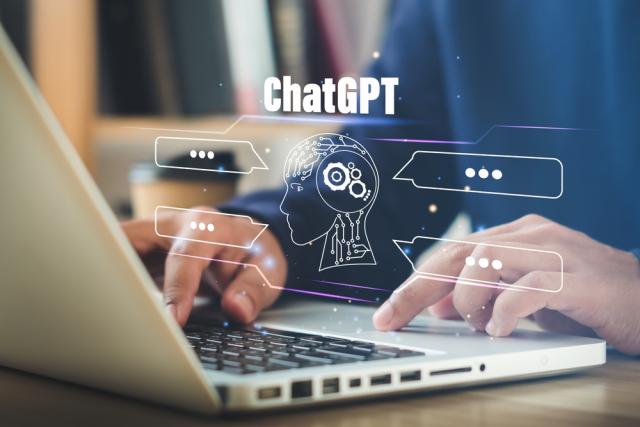
Occidental Petroleum's Shauna Noonan used ChatGPT AI technology to spice up how well intervention operations are described to people new to the industry at a keynote luncheon at the SPE/ICoTA Well Intervention Conference and Exhibition in The Woodlands.. (Source: Shutterstock)
THE WOODLANDS, Texas — Technology is remaking how the oil and gas industry gets things done, from inspection techniques to well interventions. And perhaps tech could one day ghostwrite its own story in the annals of oil and gas innovation.
For Shauna Noonan, Occidental Petroleum’s Fellow and Senior Director for International and Gulf of Mexico Supply Chain, effectively telling the story of that technology in the industry—whether it’s robotic inspections or the impressive operations in a wellbore— is essential to attract fresh talent to the industry.
“It’s time to reframe the well intervention narrative,” Noonan said on March 21 during a keynote luncheon at the SPE/ICoTA (Intervention and Coiled Tubing Association) Well Intervention Conference and Exhibition in The Woodlands.
Technology is opening new possibilities all the time: 3D printers can make food, something that was once a sci-fi idea, she said. It’s now possible to replace some oilfield workers with robots. Even scripting the tale of new and fantastic technologies can be told with technology itself, via artificial intelligence (AI).
Training Spot, the robotic dog
Occidental has been trialing the use of Spot, a robot dog developed by Boston Dynamics, for visual inspections and emissions detection at onshore and offshore facilities.
“He’s sensor-ed up to see things we can’t see, and also to see things we can see,” Noonan said.
Emerson Toloza, a robotics specialist at Occidental, is one of Spot’s handlers. Like most dogs, Spot had to be trained.
“You first manually walk through the platform facility. You teach it what you want it to look for,” he said.
Now Spot’s capable of doing visual inspections and emissions detections, and it uses different types of sensors and recording equipment.
“Autonomous inspections, that’s our goal,” Toloza said.
So far, Spot’s field trial has been a success, he said.
Occidental is expanding its robotic dog pack. Noonan said the operator had purchased additional Spots from Boston Dynamics for direct air capture (DAC) facilities.
“One of those plants has over a 60-acre footprint. They're massive,” Noonan said. “In order to do proper and timely inspections, we've actually purchased a couple more” robots.
‘The unsung heroes of oil and gas’
Google doesn’t make well intervention sound like an interesting career.
Noonan said changing the narrative of technology in well intervention will help draw in the next generation of talent.
As an experiment, she checked for definitions of wireline intervention with two sources.
First, Google, which produced a definition that was accurate and boring. Google dutifully reported that intervention prolongs the life of producing wells.
Enter ChatGPT, an artificial intelligence (AI) interface that responds to text questions and generates natural language responses.
ChatGPT variously described wireline intervention as trying to thread a needle deep underground — but a needle that is on its side and twisting.
“It’s not just a matter of lowering the wire down the wellbore, it’s like trying to steer a ship through a minefield while blindfolded,” Noonan said. “The crew has to contend with curves, angles and deviations in the wellbore that can cause the wire to kink, buckle or even break.”
In the end, ChatGPT’s version suggested that wireline crews are “the unsung heroes of the oil and gas industry.”
In short, she said, “ChatGPT gets it.”
Part of what that new AI technology gets, she said, is how many different things can be done in wellbores.
“The interesting thing is even people in our own industry don’t realize how complex and advanced and how challenging of a job you have,” Noonan said. “That’s the story we need to get out there.”
And as that story spreads, she hopes the Google definition will evolve to: “Extending the life of producing wells with minimal environmental impact by using advanced technology to safely enter complex wellbores autonomously.”
And some of that advanced technology could be a variation on Spot.
“Why can’t we have a mini-Spot to go into our wellbores to deal with plugs?” she asked.
Recommended Reading
Ohio Utica’s Ascent Resources Credit Rep Rises on Production, Cash Flow
2024-04-23 - Ascent Resources received a positive outlook from Fitch Ratings as the company has grown into Ohio’s No. 1 gas and No. 2 Utica oil producer, according to state data.
E&P Highlights: April 22, 2024
2024-04-22 - Here’s a roundup of the latest E&P headlines, including a standardization MoU and new contract awards.
US EPA Expected to Drop Hydrogen from Power Plant Rule, Sources Say
2024-04-22 - The move reflects skepticism within the U.S. government that the technology will develop quickly enough to become a significant tool to decarbonize the electricity industry.
For Sale? Trans Mountain Pipeline Tentatively on the Market
2024-04-22 - Politics and tariffs may delay ownership transfer of the Trans Mountain Pipeline, which the Canadian government spent CA$34 billion to build.
TotalEnergies to Acquire Remaining 50% of SapuraOMV
2024-04-22 - TotalEnergies is acquiring the remaining 50% interest of upstream gas operator SapuraOMV, bringing the French company's tab to more than $1.4 billion.





